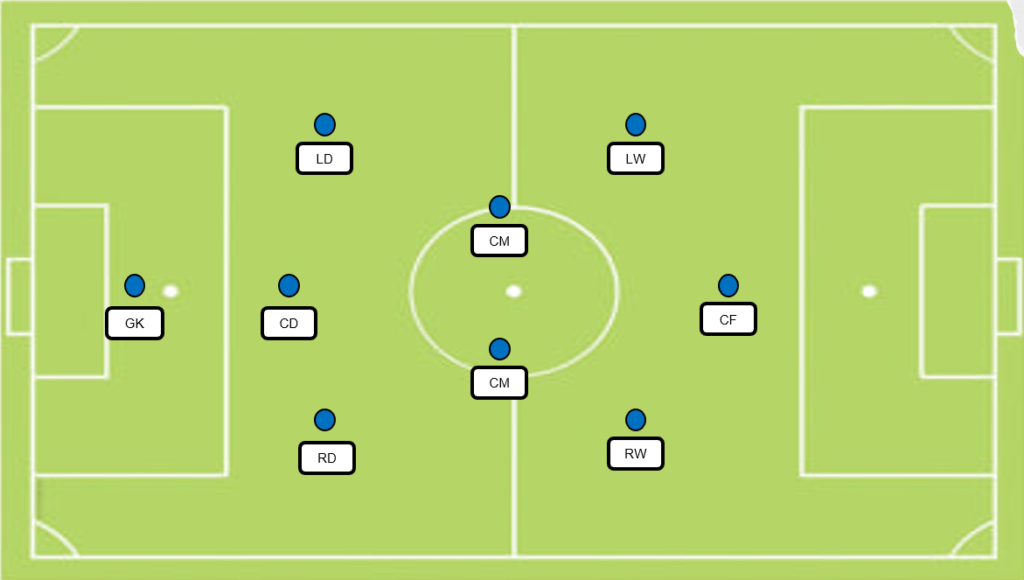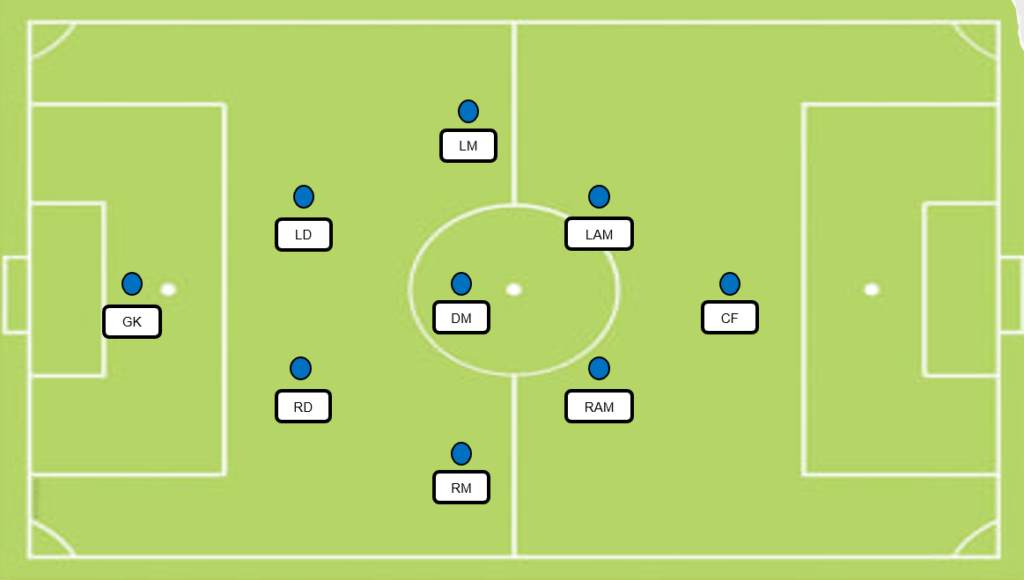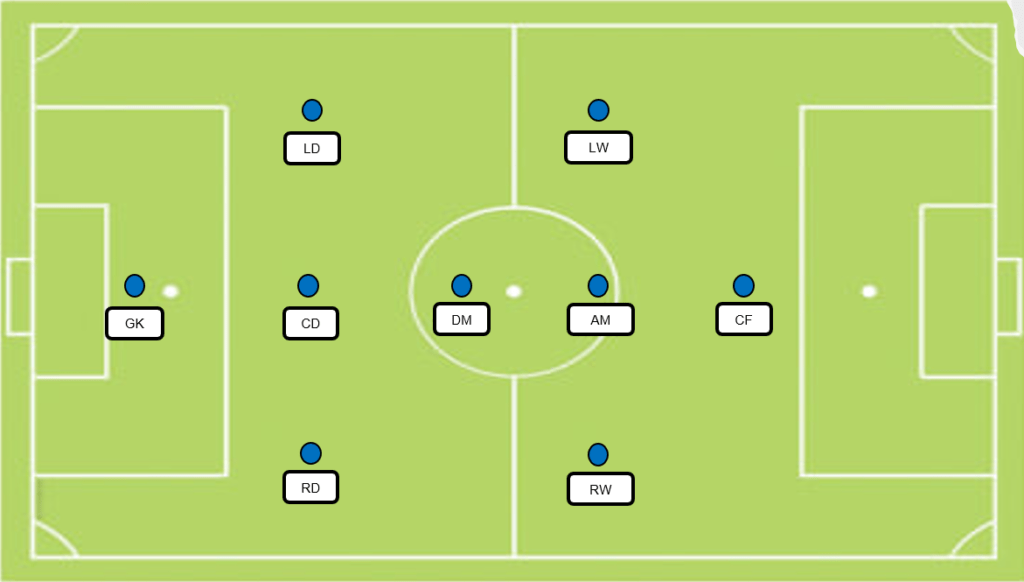The 9v9 is the last formation for grassroots football games before the official 11 v 11. The ages using the specific formations (of course this is differentiated from country to country) are between 11 – 14 years old. But, which are the best football formations for 9 v 9 teams?
It’s the first time the coach will try to introduce the fundamental principles of positioning, formations, and how to play to the strengths of their teammates.
By studying the best formations in 9v9 a lot can be learned and transferred later on over to the 11v11 game. The level of details that should be added in that stage in regards to football basic tactics is so much, thus it should be not neglected by any coach, academy director, or football club.
Below are some of the most common and very best formations to play in the highly intriguing 9v9 game.
-> 3 – 2 – 3

The 3-2-3 is one of the most regularly used football formations 9v9. It provides huge flexibility especially when the team is in possession. The 3-2-3 is excellent for creating triangles and rhombus in possession of the ball. It provides balance both in the attacking and the defensive phase.
The players are usually positioned in angles in regard to their teammates and that helps them to receive passes with the proper body position.
Transferable tactical knowledge to the 11 v 11
- 4 – 3 – 3
- 3 – 4 – 3
- 4 – 2 – 3 – 1
Benefits
- Attack-minded and possession-oriented play
- Has by default several triangles and rhombus which help to build a possession game approach
- Balanced in both phases, defensive and attacking
- Can switch to 3 – 4 – 1 by dropping back the wide players in the midfield
- Provides a solid defensive 3 as a base with central midfielders easily able to learn the art of dropping in and covering for defenders when they go on runs.
Challenges
- In the effort wingers to provide width in the attack, the forward will be left alone centrally without support
- The two midfielders can be easily outnumbered against teams playing with 3 midfielders (like 2 – 3 – 3)
- The wingers must be tactically disciplined to come back to defend
- A team without defenders with confidence to join the attack and create superiorities centrally will limit the strength of the formation
-> 2 – 3 – 3 / 2 – 3 – 2 – 1

The specific formation is probably the most balanced one in both phases, attacking and defending. The structure provides connections and cooperation in triangles. For that reason, famous academies like Barcelona and Ajax, who love to teach positional play, prefer specific formations.
There are almost all the roles from the regular 11 v 11 except classic wingers. So, a coach can train young players in clear defensive and attacking positions but at the same time give them the freedom to express themselves.
The one forward with two attacking midfielders supporting him allows a team to use the counterattack as their main or secondary strategy.
During the game, the formation can be easily transformed into a 4 – 3 – 1. This will create either a strong block in defense or more options during the build-up.
Transferable tactical knowledge to the 11 v 11
- 4 – 3 – 2 – 1 (4 – 3 – 3 with inverted wingers)
Benefits
- Can be used for positional play, possession game, or counterattack style
- Provides balance either when defending or attacking
- With minor movements it can be transformed into a 4 – 3 – 1 in defense that will offer greater safety in wide channels and a more concrete central block
- In the attack, the wide midfielders can become classic wingers ( 2 – 1 – 4 – 1) that will offer width which will allow the team to cross more in the box
- Creates loads of triangles necessary for both attack and defence.
Challenges
- The two central defenders to cover the space has a lot of danger, It requires fast, intelligent players to cover any pass behind their back or between the lines
- If the LM and RM are too wide (classic wingers) and the LAM and RAM high up the pitch, the DM will be left alone to cover the central space.
- If the DM is an attacking-minded play who will regularly push high, there will be a huge gap centrally that the LM and RM will be forced to cover by getting inside. This will cause a loss of width in the attack.
- The DM is the player who must constantly be aware of the opponent’s forward line. He is responsible to help the two central defenders wither by covering any gaps created in the defensive line or by individual marking one forward
- It is preferable for the DM to be more defended oriented and ball winner than a playmaker
-> 3 – 1 – 3 – 1

Based on the concepts of positional play, possession football, and constantly fluidly during the game, the 3 – 1 – 3 – 1 is a revolutionary formation. The formation has many similarities to the formation that the great Marcelo Bielsa uses during the attacking phase, the famous 3 – 1 – 3 – 3.
Transferable tactical knowledge to the 11 v 11
The specific formation can be excellent for teams with a great technical ability (especially in ball possession) and also a very good positional understanding.
- 4 – 2 – 3 – 1
- 4 – 1 – 4 – 1
Benefits
- The use of wide defenders and wingers provides the option for the team to attack from side areas without the danger to leave spaces behind for counter-attacks
- A possession-style team when using a 3 – 1 – 3 -1 formation has huge advantages because they can stretch the opponent’s lines by moving the ball all the width of the pitch
- The 4 clear lines provide different passing options and angles to help the ball possession
- The 3 at the back can provide a strong defensive line but also many options to build up from the back with short passes
Challenges
- Only highly technically good teams with the ability to keep the ball can play the specific formation. Any loss of the ball will have as result in the team defending with only 4 players (usually the wingers will be caught high up on the pitch)
- If wingers and AM are not willing to do the defensive work, the DM will be all alone to defend the central areas
- There is a big gap between the wide defenders and wingers because there are no central midfielders who can drag wide to defend or offer passing options. Opponents with wide attackers can exploit these spaces
- In case of defenders driving forward with the ball, the one DM will not be able to cover him and leave the central area empty
-> 3 – 3 – 2

This is probably the formation that most coaches start to use when coaching a 9 v 9 team. It has 3 clear lines that can help a coach teach the main defensive principles of zonal defending (pressure and cover) but also some of the main attacking principles (width, depth, and mobility to provide options).
This is the formation close to the classic 4 – 4 – 2, widely used by many teams, especially when defending. It’s the most simple to teach formation because the positions are very clear, there is always coverage from the players behind and in front and each position will have basic instructions to teach.
Transferable tactical knowledge to the 11 v 11
- 4 – 4 – 2
- 3 – 5 – 2
Benefits
- Simple formation to teach young players basic fundamentals of each position
- Equally covers almost all the areas of the pitch
- GIves the opportunity to work the two forwards attacking combinations which many formations have (4 – 4 – 2, 3 – 5 – 2)
- Any ball loss has less danger to result in a goal (like other formations) because of the near players ready to provide coverage
Challenges
- The 3 midfielders wh oare responsible to cover the whole width of the pitch may have challenges to understand their clear instructions because many times will be forced to drag wide
- Opponents can create numerical superiority in the central areas, especially if the LM and RM have a tendency to get in wide areas
- If the 3 midfielders are more defending-oriented, the two forwards can be easily isolated
- It does not provide the opportunity for the players to be more fluid and move free because the balance of the structure will be lost.
- The 3 lines may create problems in the defensive phase if opponent’s puts players between the lines and play a vertical game
Conclusion for the best football formations for 9 v 9
So, which are the best football formations for 9 v 9?
The 9v9 stage in grassroots is one of the most challenging periods in a young player’s life but also in a coach’s career. From a coaching perspective, it requires a high lvele of tactical understanding without forgetting that the players are still learning the fundamental principles of the game.
The above are here only to provide a simple guide for coaches to understand the benefits and challenges of each formation. Of course, each formation’s success differs depending on the characteristics of the team which implements it.
Before a coach will choose which formation to use, it is essential to udnrstand his team’s and his player’s strengths and weaknesses. The best option is to train a team to be able to play at least two different formations. In that way, the players will be more adaptable in different situations but also will have the opportunity to be trained in more concepts which will help them to have a more easy transition to the 11 v 11 football.
For more practical and theoretical reading on Positional Play you can read the below magnificent books:


Everything is very open with a clear clarification of the issues. It was truly informative. Your website is very useful. Thanks for sharing!
Thank you for your comments!!!! Feedback is always valuable.!!